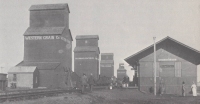|
In the early 1800’s, fur
trading was about the only business done in the region that now is
Wisconsin, until lead mining began to grow in the southwestern part of the
area, not far from Galena, Ill. This culminated in a lead “rush” beginning
in 1825, which in turn brought in a number of settlers.
Before 1800, there were
probably only about 200 non-Indian residents of the Wisconsin region, but
lead mining was to bring population growth to some 3,200 in 1830 and then
11,000 by 1836. It was in 1836 that the “Territory of Wiskonsan” was
organized, including what now is Wisconsin, Iowa, Minnesota and part of
the Dakotas.
Population continued to
grow, jumping to nearly 31,000 in 1840, to 44,000 in 1842, to more than
155,000 in 1846, and then it more than doubled in the decade of the
1850’s.
During this growth, lead
mining reached its peak in about 1847 and then began to decline. As lead
declined, agriculture took its place, particularly wheat farming.
In that era, Wisconsin’s
wheat crop came to be the second largest in the nation, rising from a
total of four million bushels in 1849 to multiply in volume seven
 times over
the next seven years, then remaining fairly constant at 28 million bushels
annually through 1860. times over
the next seven years, then remaining fairly constant at 28 million bushels
annually through 1860.
Lumbering also began to
become a significant industry, starting up in the 1830’s along the
Chippewa, Black and St. Croix rivers.
|
|
|
1800's Wisconsin |
